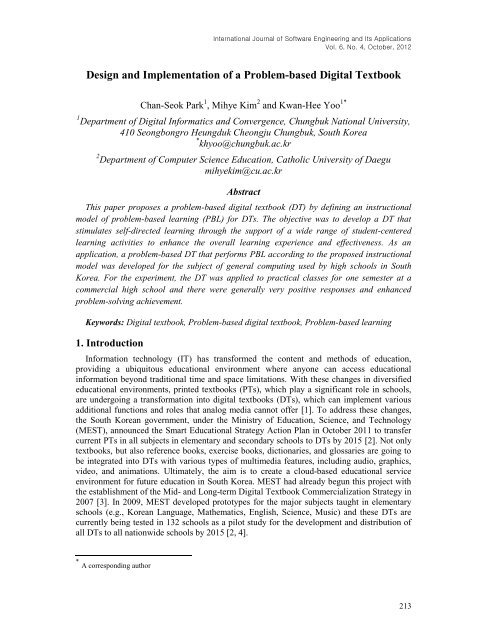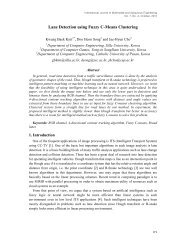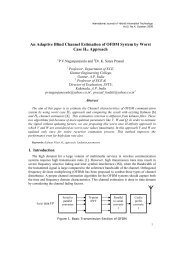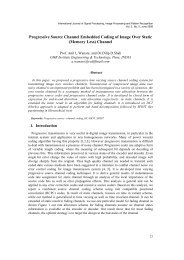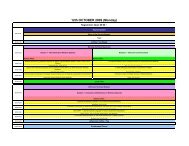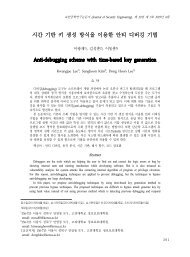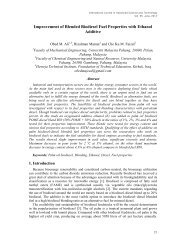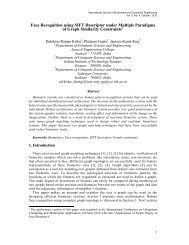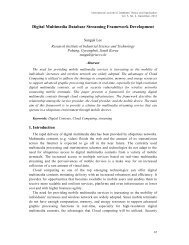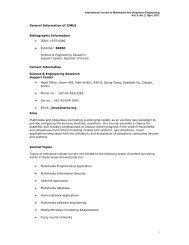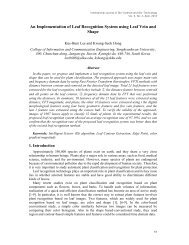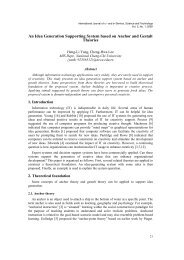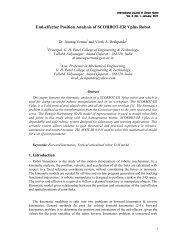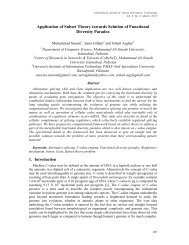Design and Implementation of a Problem-based Digital ... - SERSC
Design and Implementation of a Problem-based Digital ... - SERSC
Design and Implementation of a Problem-based Digital ... - SERSC
Create successful ePaper yourself
Turn your PDF publications into a flip-book with our unique Google optimized e-Paper software.
International Journal <strong>of</strong> S<strong>of</strong>tware Engineering <strong>and</strong> Its Applications<br />
Vol. 6, No. 4, October, 2012<br />
<strong>Design</strong> <strong>and</strong> <strong>Implementation</strong> <strong>of</strong> a <strong>Problem</strong>-<strong>based</strong> <strong>Digital</strong> Textbook<br />
Chan-Seok Park 1 , Mihye Kim 2 <strong>and</strong> Kwan-Hee Yoo 1*<br />
1 Department <strong>of</strong> <strong>Digital</strong> Informatics <strong>and</strong> Convergence, Chungbuk National University,<br />
410 Seongbongro Heungduk Cheongju Chungbuk, South Korea<br />
* khyoo@chungbuk.ac.kr<br />
2 Department <strong>of</strong> Computer Science Education, Catholic University <strong>of</strong> Daegu<br />
mihyekim@cu.ac.kr<br />
Abstract<br />
This paper proposes a problem-<strong>based</strong> digital textbook (DT) by defining an instructional<br />
model <strong>of</strong> problem-<strong>based</strong> learning (PBL) for DTs. The objective was to develop a DT that<br />
stimulates self-directed learning through the support <strong>of</strong> a wide range <strong>of</strong> student-centered<br />
learning activities to enhance the overall learning experience <strong>and</strong> effectiveness. As an<br />
application, a problem-<strong>based</strong> DT that performs PBL according to the proposed instructional<br />
model was developed for the subject <strong>of</strong> general computing used by high schools in South<br />
Korea. For the experiment, the DT was applied to practical classes for one semester at a<br />
commercial high school <strong>and</strong> there were generally very positive responses <strong>and</strong> enhanced<br />
problem-solving achievement.<br />
Keywords: <strong>Digital</strong> textbook, <strong>Problem</strong>-<strong>based</strong> digital textbook, <strong>Problem</strong>-<strong>based</strong> learning<br />
1. Introduction<br />
Information technology (IT) has transformed the content <strong>and</strong> methods <strong>of</strong> education,<br />
providing a ubiquitous educational environment where anyone can access educational<br />
information beyond traditional time <strong>and</strong> space limitations. With these changes in diversified<br />
educational environments, printed textbooks (PTs), which play a significant role in schools,<br />
are undergoing a transformation into digital textbooks (DTs), which can implement various<br />
additional functions <strong>and</strong> roles that analog media cannot <strong>of</strong>fer [1]. To address these changes,<br />
the South Korean government, under the Ministry <strong>of</strong> Education, Science, <strong>and</strong> Technology<br />
(MEST), announced the Smart Educational Strategy Action Plan in October 2011 to transfer<br />
current PTs in all subjects in elementary <strong>and</strong> secondary schools to DTs by 2015 [2]. Not only<br />
textbooks, but also reference books, exercise books, dictionaries, <strong>and</strong> glossaries are going to<br />
be integrated into DTs with various types <strong>of</strong> multimedia features, including audio, graphics,<br />
video, <strong>and</strong> animations. Ultimately, the aim is to create a cloud-<strong>based</strong> educational service<br />
environment for future education in South Korea. MEST had already begun this project with<br />
the establishment <strong>of</strong> the Mid- <strong>and</strong> Long-term <strong>Digital</strong> Textbook Commercialization Strategy in<br />
2007 [3]. In 2009, MEST developed prototypes for the major subjects taught in elementary<br />
schools (e.g., Korean Language, Mathematics, English, Science, Music) <strong>and</strong> these DTs are<br />
currently being tested in 132 schools as a pilot study for the development <strong>and</strong> distribution <strong>of</strong><br />
all DTs to all nationwide schools by 2015 [2, 4].<br />
* A corresponding author<br />
213
International Journal <strong>of</strong> S<strong>of</strong>tware Engineering <strong>and</strong> Its Applications<br />
Vol. 6, No. 4, October, 2012<br />
The main focus <strong>of</strong> the current development <strong>of</strong> DTs is to completely transfer the contents <strong>of</strong><br />
all PTs to computer-<strong>based</strong> books by integrating several learning materials with the benefits <strong>of</strong><br />
multimedia features. This effort is worthwhile to give birth to new forms <strong>of</strong> future education<br />
materials; however, the development <strong>of</strong> DTs should also focus on the implementation <strong>of</strong><br />
various instructional methods to provide more diverse learning activities <strong>and</strong> improve student<br />
learning achievement with greater efficiency <strong>and</strong> effectiveness. In this paper, we propose a<br />
DT that enables the performance <strong>of</strong> problem-<strong>based</strong> learning (PBL) to enhance the overall<br />
learning experience <strong>and</strong> its effectiveness, <strong>and</strong> to provide a much wider range <strong>of</strong> learning<br />
activities in a self-directed learning environment. The problem-<strong>based</strong> DT aims to help<br />
students develop more flexible knowledge, problem-solving skills, <strong>and</strong> collaboration skills<br />
through means <strong>of</strong> self-directed learning [5]. As a prototype for this proposal, we defined an<br />
instructional model <strong>of</strong> PBL for DTs <strong>and</strong> developed a problem-<strong>based</strong> DT for the subject <strong>of</strong><br />
general computing used in commercial high schools in Korea [6].<br />
The remainder <strong>of</strong> this paper is organized as follows. Section 2 reviews the theoretical<br />
background <strong>of</strong> the study, including that pertaining to PBL <strong>and</strong> DTs. Section 3 presents the<br />
instructional model <strong>of</strong> the PBL we defined for the proposed DT, <strong>and</strong> Section 4 presents the<br />
prototype <strong>of</strong> the DT implemented to perform PBL in accordance with the proposed PBL<br />
instructional model. Section 5 concludes the paper with some results from an experimental<br />
application to real classrooms.<br />
2. Theoretical Background<br />
2.1. <strong>Problem</strong>-<strong>based</strong> Learning<br />
Student-centered pedagogies have long attracted much attention in the education sector;<br />
one <strong>of</strong> them is PBL [7]. PBL switches the educational paradigm from teaching to learning,<br />
emphasizing what students are learning rather than what instructors are teaching [8]. In this<br />
methodology, a problem is given to students first in the process <strong>of</strong> learning, unlike traditional<br />
instruction approaches. Students then achieve their learning from the process <strong>of</strong> working<br />
towards underst<strong>and</strong>ing <strong>and</strong> solving the problem <strong>and</strong> reflecting on their practical experiences<br />
in solving the problem [9]. PBL helps students become active learners by situating learning in<br />
real-world problems in the direction <strong>of</strong> experiential learning. The goals <strong>of</strong> PBL are to help<br />
students to “1) construct an extensive <strong>and</strong> flexible knowledge base, 2) develop effective<br />
problem-solving skills, 3) develop self-directed, lifelong learning skills, 4) become effective<br />
collaborators, <strong>and</strong> 5) become intrinsically motivated to learn” [5]<br />
Figure 1 shows the learning cycle <strong>of</strong> PBL. First, the teacher has to develop a problem<br />
scenario <strong>and</strong> present it to the students. <strong>Problem</strong>s should be developed carefully so that they<br />
are complex, multifaceted, <strong>and</strong> realistic [10] Students analyze the problem scenario carefully<br />
by identifying key issues <strong>and</strong> relevant facts. Following this, they formulate hypotheses on<br />
possible solutions to the problem. Then they derive their learning needs by identifying what<br />
they already know that is relevant to the problem <strong>and</strong> what they need to know to be able to<br />
solve the problem. After that, students conduct research <strong>and</strong> gather the knowledge <strong>and</strong><br />
information required to solve the problem, referring to various forms <strong>of</strong> learning resources<br />
<strong>and</strong> acquiring new knowledge <strong>and</strong> information through self-directed learning, then applying<br />
them to resolve the problem. Then, they evaluate their ideas <strong>and</strong> hypotheses <strong>based</strong> on the new<br />
facts they acquired <strong>and</strong> finally they generate solutions. The role <strong>of</strong> the teacher is that <strong>of</strong> a<br />
facilitator to guide student activities <strong>and</strong> learning through the process <strong>of</strong> PBL [5].<br />
214
International Journal <strong>of</strong> S<strong>of</strong>tware Engineering <strong>and</strong> Its Applications<br />
Vol. 6, No. 4, October, 2012<br />
2.2. <strong>Digital</strong> Textbook<br />
Figure 1. The <strong>Problem</strong>-<strong>based</strong> Learning Cycle [5]<br />
DTs were originally known as electronic books (e-books), but since 2007 they have been<br />
called “digital textbooks” to emphasize their teaching <strong>and</strong> learning functions <strong>and</strong> roles in<br />
schools 11 . That is, DTs focus on formal <strong>and</strong> functional aspects <strong>of</strong> educational materials that<br />
students <strong>and</strong> teachers use in schools, so they are used in a comparatively limited way versus<br />
e-books generally [1].<br />
Consequently, DTs can be defined as curriculum-<strong>based</strong> electronic textbooks for students<br />
that can be read on various types <strong>of</strong> devices, such as desktop computers, notebooks, tablet<br />
computers, or dedicated devices through wired or wireless networks, without time or space<br />
limitations. DTs can support richer learning content with a combination <strong>of</strong> various learning<br />
materials, including not only textbooks, reference books, workbooks, dictionaries, <strong>and</strong><br />
hyperlinks, but also multimedia content, such as audio, 3D graphics, animations, video, <strong>and</strong><br />
virtual <strong>and</strong> augmented reality. That is, DTs can provide the features <strong>of</strong> traditional printed<br />
textbooks (PTs), with the added benefits <strong>of</strong> IT <strong>and</strong> various multimedia features [1, 12, 13].<br />
As a result, DTs have a number <strong>of</strong> benefits over PTs; they can support more diverse<br />
learning opportunities <strong>and</strong> a much wider range <strong>of</strong> learning activities with rich learning content<br />
by combining several educational materials with various types <strong>of</strong> multimedia features <strong>and</strong><br />
information delivery methods in a ubiquitous educational environment. They can also quickly<br />
accommodate the latest information <strong>and</strong> new knowledge <strong>and</strong> changes [1, 12]. In addition,<br />
DTs can facilitate more dynamic interactions, not only between students <strong>and</strong> teachers, but<br />
also with digital content. Moreover, they can facilitate self-directed learning with media-rich<br />
learning content, resulting in improved student learning achievement [1, 5, 14].<br />
The main functions <strong>of</strong> DTs include the basic features <strong>of</strong> PTs (e.g., memo <strong>and</strong> note taking,<br />
underlining <strong>and</strong> highlighting, viewing DTs by page units, indicating page numbers, page<br />
turning, bookmarks) <strong>and</strong> the supplementary features <strong>of</strong> IT <strong>and</strong> digital media. These additional<br />
features can include display functions (e.g., display texts, images, zooming in <strong>and</strong> out, page<br />
turning), input functions (e.g., writing documents, memos <strong>and</strong> notes, creating a table <strong>of</strong><br />
memos <strong>and</strong> notes, voice memos), moving (i.e., moving to a particular page), <strong>and</strong> search<br />
functions, in addition to the multimedia features mentioned above <strong>and</strong> learning support<br />
functions (hyperlinks, interactions, file transmissions, assessments, creating learning content)<br />
[13, 14, 15]. More features will emerge as various DTs evolve.<br />
215
International Journal <strong>of</strong> S<strong>of</strong>tware Engineering <strong>and</strong> Its Applications<br />
Vol. 6, No. 4, October, 2012<br />
3. <strong>Design</strong> <strong>of</strong> <strong>Problem</strong>-<strong>based</strong> <strong>Digital</strong> Textbook<br />
3.1. Instructional Model <strong>of</strong> <strong>Problem</strong>-<strong>based</strong> Learning for <strong>Digital</strong> Textbooks<br />
In this study, an instructional model <strong>of</strong> PBL for DTs was defined on the basis <strong>of</strong> the<br />
learning cycle <strong>of</strong> PBL, described by Barrow [16] <strong>and</strong> Hmelo-Silver [5]. Barrow, a founder <strong>of</strong><br />
PBL, suggested the process <strong>of</strong> PBL in three phases: problem analysis, self-directed learning,<br />
<strong>and</strong> synthesis <strong>and</strong> application <strong>of</strong> newly acquired information. Hmelo-Silver divided the<br />
process into six phases, as presented in Figure 1. We redefined these procedures to suit DTs,<br />
as shown in Figure 2.<br />
Figure 2. A Proposed Instructional Model <strong>of</strong> PBL for DTs<br />
3.2. Instructional Model <strong>of</strong> <strong>Problem</strong>-<strong>based</strong> Learning for <strong>Digital</strong> Textbooks<br />
Table 1 shows the features <strong>of</strong> the DT we propose in this study. It focuses on the features<br />
that can support the process <strong>of</strong> PBL, along with the basic <strong>and</strong> multimedia features <strong>of</strong> DTs.<br />
Various outside learning resources <strong>and</strong> materials, such as references, blogs, glossaries <strong>and</strong><br />
dictionaries, images, <strong>and</strong> pictures, are also provided <strong>and</strong> hyperlinked to the DT to stimulate<br />
self-directed learning. Search features are also supported to allow students to find new<br />
knowledge <strong>and</strong> information associated with problem solving within the DT or in outside<br />
learning resources linked to the DT. Assessment functions are also provided for evaluating<br />
the problem-solving results <strong>and</strong> for determining each student’s level <strong>of</strong> underst<strong>and</strong>ing for<br />
supplementary <strong>and</strong> enrichment learning. Furthermore, various interactive features, such as e-<br />
mails, bulletin boards, chatting, <strong>and</strong> specific websites to allow students to communicate with<br />
each other for problem solving, are supported. Moreover, a number <strong>of</strong> authoring tools are<br />
provided to enable teachers to create problem content, as well as allowing student to generate<br />
problem-solving results (reports).<br />
216
International Journal <strong>of</strong> S<strong>of</strong>tware Engineering <strong>and</strong> Its Applications<br />
Vol. 6, No. 4, October, 2012<br />
4. <strong>Implementation</strong> <strong>of</strong> a <strong>Problem</strong>-<strong>based</strong> <strong>Digital</strong> Textbook<br />
As an application <strong>of</strong> the above protocols, we developed a problem-<strong>based</strong> DT for a unit <strong>of</strong><br />
the general computing subject used in commercial high schools in Korea. The unit content<br />
was related to the underst<strong>and</strong>ing <strong>of</strong> a graphics editing program (Adobe Photoshop) <strong>and</strong><br />
learning how to use it. The DT was implemented to perform PBL in lesson units following<br />
the instructional model <strong>of</strong> the six phases presented in Figure 2.<br />
Table 1. Features <strong>of</strong> the Proposed <strong>Problem</strong>-<strong>based</strong> <strong>Digital</strong> Textbook<br />
Feature Details Explanation<br />
Basic Features -Perform the functions <strong>and</strong> roles <strong>of</strong> traditional PTs<br />
Learning as<br />
Function a textbook<br />
-Achieve the same educational goals as traditional PTs (e.g., writing,<br />
memos <strong>and</strong> notes, underlining <strong>and</strong> highlighting, page turning, page<br />
Learning<br />
Support<br />
Function<br />
Learning<br />
Management<br />
Function<br />
moving, bookmarks, table <strong>of</strong> contents, index)<br />
Multimedia -Provide various types <strong>of</strong> multimedia objects (e.g., images, sounds,<br />
Function graphics, 3D motion graphics, animations, videos, virtual <strong>and</strong><br />
augmented reality)<br />
References -Provide various learning materials for self-directed learning<br />
Glossaries -Provide glossaries <strong>and</strong> dictionaries required for learning<br />
Search -Find information or knowledge within the DT or in other learning<br />
Function resources hyperlinked to the DT<br />
Hyperlinks -Hyperlinks to a variety <strong>of</strong> learning materials <strong>and</strong> resources to stimulate<br />
self-directed learning<br />
Interactions -Interactions between the teacher <strong>and</strong> students on the Web (e.g., e-mail,<br />
bulletin board, websites, chatting)<br />
Evaluation<br />
Tools<br />
-Support assessment tools<br />
-Provide supplementary or enrichment learning content by student<br />
underst<strong>and</strong>ing level<br />
Learning -Manage students’ e-portfolios<br />
Management -Determine each student’s underst<strong>and</strong>ing level<br />
Authoring<br />
Tools<br />
-Create/Edit/Print problem-solving results using authoring tools (e.g.,<br />
edit text, picture, 3D graphic, music, audio)<br />
The screen composition <strong>of</strong> the DT basically adheres to the paradigm <strong>of</strong> general PTs,<br />
considering students’ experience with PTs. The content <strong>of</strong> the DT is composed <strong>of</strong> text, sound,<br />
graphics, animations, virtual reality, <strong>and</strong> augmented reality. The teaching <strong>and</strong> learning<br />
materials <strong>of</strong> the DT were designed to be applicable to actual school classes. Furthermore,<br />
lecture notes in PowerPoint format (.ppt) were also provided for teacher-centered classes. The<br />
DT was developed on a desktop computer, but could be operated on a tablet computer.<br />
Figure 3 shows the screen configuration <strong>of</strong> the proposed problem-<strong>based</strong> DT. Following the<br />
proposed PBL instructional model for DTs, the teacher first give a brief explanation <strong>of</strong> the<br />
learning method for the lesson <strong>and</strong> selects the learning unit for the lesson in the DT.<br />
217
International Journal <strong>of</strong> S<strong>of</strong>tware Engineering <strong>and</strong> Its Applications<br />
Vol. 6, No. 4, October, 2012<br />
Figure 3. Screen Configuration <strong>of</strong> the Proposed <strong>Problem</strong>-<strong>based</strong> DT<br />
The teacher starts the class by showing animations or an audio to motivate the students <strong>and</strong><br />
presents learning objectives <strong>and</strong> guides students to download the problem for PBL. The<br />
problem can be solved by individual learning or group learning, depending on the content <strong>of</strong><br />
the learning unit. The students are informed about the learning materials <strong>and</strong> resources needed<br />
to solve the problem. Students analyze <strong>and</strong> identify the key issues <strong>of</strong> the problem, <strong>and</strong> then<br />
review possible ways to resolve the problem with group members, along with finding<br />
information <strong>and</strong> knowledge related to problem solving. After that, the students generate their<br />
final report on the learning activity sheet provided on the DT using the authoring tools. Then<br />
they submit their final report to the teacher through the DT, <strong>and</strong> the reports are released on a<br />
bulletin board in the DT for cross-referencing. The teacher can provide feedback on the final<br />
results. Figure 4 <strong>and</strong> Figure 5 show the description <strong>of</strong> a problem <strong>and</strong> an example <strong>of</strong> finding<br />
information associated with the problem. Figure 6 <strong>and</strong> Figure 7 show examples <strong>of</strong> a groupregistration<br />
process for group learning <strong>and</strong> a final result submission for the problem.<br />
218
International Journal <strong>of</strong> S<strong>of</strong>tware Engineering <strong>and</strong> Its Applications<br />
Vol. 6, No. 4, October, 2012<br />
Figure 4. An Example <strong>of</strong> a <strong>Problem</strong> Description<br />
Figure 5. An Example <strong>of</strong> Finding Information Related to the <strong>Problem</strong><br />
219
International Journal <strong>of</strong> S<strong>of</strong>tware Engineering <strong>and</strong> Its Applications<br />
Vol. 6, No. 4, October, 2012<br />
Figure 6. An Example <strong>of</strong> a Group-registration Process for Collaborative Groups<br />
5. Conclusion<br />
Figure 7. An Example <strong>of</strong> a Final Result Submission<br />
We designed an instructional model for PBL with DTs <strong>and</strong> developed a problem-<strong>based</strong> DT<br />
that performed PBL following the proposed PBL process. The objective was to develop a DT<br />
that supported a self-directed learning environment through a much wider range <strong>of</strong> studentcentered<br />
learning activities, as well as a customized learning environment to accommodate<br />
students’ needs, preferences, <strong>and</strong> underst<strong>and</strong>ing levels to help students develop more flexible<br />
knowledge <strong>and</strong> problem-solving skills, <strong>and</strong> improve their learning achievements.<br />
As an application <strong>of</strong> the proposed approach, a DT was implemented <strong>and</strong> applied to actual<br />
classrooms for one semester at a commercial high school in Korea. To verify the educational<br />
220
International Journal <strong>of</strong> S<strong>of</strong>tware Engineering <strong>and</strong> Its Applications<br />
Vol. 6, No. 4, October, 2012<br />
effectiveness <strong>of</strong> the problem-<strong>based</strong> DT, two learning achievement tests (LAT) <strong>and</strong> three<br />
surveys on the DT were conducted after using the DT for two semesters. The experimental<br />
results showed that students’ problem-solving performance <strong>and</strong> abilities were improved after<br />
using the DT, compared to using PTs. In particular, the learning performance <strong>of</strong> lower-level<br />
students (i.e., the 0~24.9% percentile) was improved after DT usage. In addition, the results<br />
<strong>of</strong> a survey on user satisfaction, usability, <strong>and</strong> perceptions about the DT were generally very<br />
positive. In future research, more diversified teaching <strong>and</strong> learning methods should be<br />
implemented in DTs to enhance their pedagogical advancement. This study will provide some<br />
guidance <strong>and</strong> direction for the development <strong>of</strong> other instructional methodologies in DTs.<br />
Acknowledgements<br />
This research was financially supported by the Ministry <strong>of</strong> Education, Science Technology<br />
(MEST) <strong>and</strong> National Research Foundation <strong>of</strong> Korea (NRF) through the Human Resource<br />
Training Project for Regional Innovation, <strong>and</strong> by the National Research Foundation <strong>of</strong><br />
Korea(NRF) grant funded by the Korea government(MEST)(No. 2012-0000479).<br />
References<br />
[1] M. Kim, K. H. Yoo, C. Park <strong>and</strong> J. S. Yoo, “Development <strong>of</strong> a <strong>Digital</strong> Textbook St<strong>and</strong>ard Format Based on<br />
XML”, LNCS, vol. 6059, (2010).<br />
[2] Ministry <strong>of</strong> Science, Education <strong>and</strong> Technology, “Road to an Advanced Country: Smart Educational Strategy<br />
Action Plan”, Republic <strong>of</strong> Korea, http://www.mest.go.kr/web/1127/ko/board/view.do?bbsId=192<br />
&mode=view&boardSeq=25734, (2011).<br />
[3] Ministry <strong>of</strong> Science, Education <strong>and</strong> Technology, “Strategy for Commercial Use <strong>of</strong> <strong>Digital</strong> Textbook”,<br />
Republic <strong>of</strong> Korea, http://www.nhrd.net/nhrd-app/jsp/tre0202.jsp?sSeq=20070255, (2007).<br />
[4] Korean Education <strong>and</strong> Research Information Service, “<strong>Digital</strong> Textbook”, http://www.dtbook.kr/renew/<br />
english/index.htm, (2012).<br />
[5] C. E. Hmelo-Silver, “<strong>Problem</strong>-<strong>based</strong> learning: What <strong>and</strong> How Do Students Learn?”, Educational Psychology<br />
Review, vol. 16, no. 3, (2004).<br />
[6] C. S. Park, “Project-<strong>based</strong> learning method employing digital textbook”, Master Thesis. Graduate School <strong>of</strong><br />
Education, Chungbuk National University, South Korea, (2011).<br />
[7] K. M. Ku, “Study on the Improvement <strong>of</strong> Computer Knowledge <strong>and</strong> Practical Skills by Applying Task-Based<br />
Learning”, Master Thesis. Graduate School <strong>of</strong> Education, Gyeongin National University <strong>of</strong> Education, South<br />
Korea, (2003).<br />
[8] R. J. Barr <strong>and</strong> J. Tagg, “From Teaching to Learning: A New Paradigm for Underst<strong>and</strong>ing Education”, Change,<br />
vol. 27, no. 6, (1995).<br />
[9] H. Barrows <strong>and</strong> R. Tamblyn, “<strong>Problem</strong>-<strong>based</strong> Learning: An Approach to Medical Education”, New York,<br />
Springer, (1980).<br />
[10] Wikipedia, “<strong>Problem</strong>-<strong>based</strong> Learning”, http://en.wikipedia.org/wiki/<strong>Problem</strong>-<strong>based</strong>_learning, (2012)<br />
February.<br />
[11] E. Jung, “Status <strong>and</strong> Future Direction <strong>of</strong> <strong>Digital</strong> Textbook”, Institute for Information Technology<br />
Advancement, Weekly Technology Trends, vol. 1347, (2008).<br />
[12] K. Yim, “Future Education <strong>and</strong> <strong>Digital</strong> Textbook”, Journal <strong>of</strong> Korea Textbook Research, Korea Textbook<br />
Research Foundation, vol. 51, (2007).<br />
[13] Wikipedia, “<strong>Digital</strong> textbook”, http://en.wikipedia.org/wiki/<strong>Digital</strong>_textbook, (2012) February.<br />
[14] H. Byun, W. Cho, N. Kim, J. Ryu, G. Lee <strong>and</strong> J. Song, “A Study on the Effectiveness Measurement on<br />
Electronic Textbook”, Korean Education <strong>and</strong> Research Information Service. Research Report CR 2006-38,<br />
Republic <strong>of</strong> Korea, (2006).<br />
[15] M. Kim, K. H. Yoo, C. Park, J. S. Yoo, B. Byun, W. Cho, J. Ryu <strong>and</strong> N. Kim, “An XML-Based <strong>Digital</strong><br />
Textbook <strong>and</strong> its Educational Effectiveness” LNCS, vol. 6059, (2010).<br />
[16] H. S. Barrow, “A taxonomy <strong>of</strong> problem-<strong>based</strong> learning methods”, Medical Education, vol. 20, (1986).<br />
221
International Journal <strong>of</strong> S<strong>of</strong>tware Engineering <strong>and</strong> Its Applications<br />
Vol. 6, No. 4, October, 2012<br />
Authors<br />
Chan-Seok Park<br />
He is a teacher who is working for a high school, Korea. He received<br />
the M.S. in information computer division from Chungbuk National<br />
University in 2011. His research interests include u-Learning systems,<br />
computer graphics, digital textbook.<br />
Mihye Kim<br />
She received her Ph.D. in Computer Science <strong>and</strong> Engineering in 2003,<br />
from New South Wales University, Sydney, Australia. She is currently an<br />
Associate Pr<strong>of</strong>essor in the Computer Science Education Department at<br />
Catholic University <strong>of</strong> Daegu, South Korea. Her research interests<br />
include knowledge management <strong>and</strong> retrieval, computer science<br />
education, e-learning, <strong>and</strong> digital textbooks.<br />
Kwan-Hee Yoo<br />
He is a pr<strong>of</strong>essor who is working for Department <strong>of</strong> <strong>Digital</strong><br />
Informatics <strong>and</strong> Convergence at Chungbuk National University, Korea.<br />
He received the B.S. in Computer Science from Chonbuk National<br />
University, Korea in 1985, <strong>and</strong> also received M.S., Ph.D. in computer<br />
science from KAIST (Korea Advanced Institute <strong>of</strong> Science <strong>and</strong><br />
Technology), Korea in 1988 <strong>and</strong> 1995, respectively. His research<br />
interests include u-Learning systems, computer graphics, 3D character<br />
animation, dental/medical applications.<br />
222


